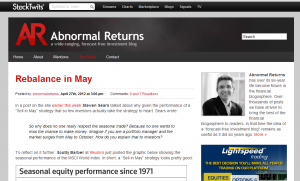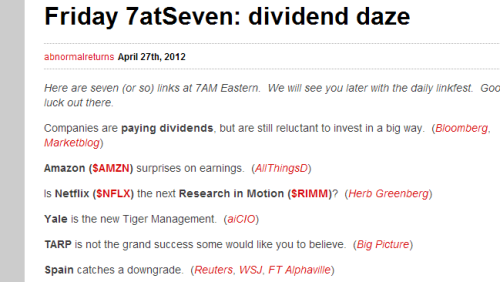By Junior Yearwood
Counterparties.com is a new Reuters website that is edited by Felix Salmon and Ryan McCarthy. Ryan McCarthy is also a deputy editor at Reuters.com. Prior to working at Reuters he held the position of business editor at the Huffington Post. Felix Salmon is a UK native with a knack for getting attention, as with recent suggestion that The New York Times might choose to sell some of their information, before publishing it, to hedge funds. In addition to blogging for Thomson Reuters, he’s written for Euromoney magazine and the Bridge News Service, created the Economonitor blog for Roubini Global and the Market Movers blog for Portfolio.com. Like me, they both Tweet: @felixsalmon and @ mccarthyryanj.
Presentation
Counterparties.com is part of the Reuters network, and that connection is reflected in the site’s slick design and corporate feel. The design and layout is crisp, smooth and professional. I particularly liked the background color choices. The top and bottom zones are done in a muted red while the main body is in plain white. It has the effect of clearly demarcating the main body of content from the secondary zones. It is a simple design choice that has a big effect, and shows the importance of a good design team.
Content is presented in four distinct segments. The top row contains four featured stories. Each contains a prominently displayed picture, a rewritten headline of the story, a link to the website and another link to a discussion board.
There are two columns in the main body. The main body of the website is divided into two parts the right side is a narrow column that is divided into three sections. The wide left hand column contains what the editors’ describe as the day’s best stories. The presentation is information-rich:
 Each story has a clickable tag (“deals”). Click and you get an index of all stories in that category. There’s a linked title (“Twitter made”) and source (venturebeat.com). There are links to discuss or Tweet the article. Each entry ends with a Tweet about the article or with a link to a related story. The second story is presented with a small favicon or avatar and a one sentence headline that you can click to get the full story. The articles are divided into sections that are clearly separated and easy to differentiate.
Each story has a clickable tag (“deals”). Click and you get an index of all stories in that category. There’s a linked title (“Twitter made”) and source (venturebeat.com). There are links to discuss or Tweet the article. Each entry ends with a Tweet about the article or with a link to a related story. The second story is presented with a small favicon or avatar and a one sentence headline that you can click to get the full story. The articles are divided into sections that are clearly separated and easy to differentiate.
The narrower right hand column contains The River and The Browser. The River contains “stories we love,” and are sometimes presented in a lighthearted manner. The teaser to one River story declares, “It’s about more than underwear, it’s about redefining what it means to be made in America (4/26).” Unlike the main stories, The River’s presentation is understated: source, category, and teaser. Below The River there are links to “stuff we’re not linking to” and a tally of the sites they most frequently link to (New York Times, Bloomberg, Wall Street Journal, Reuters) and then a feed from a website called The Browser. Its editors note, “The Browser is not a news website. Our priority is to curate writing of lasting value – whatever its length or form.” During my visit, the feed highlighted stories on intolerance in Saudi textbooks, Gerard Mercator’s 500th birthday and why thinking in a foreign language makes for better decisions.
The site suffers from three small design weaknesses:
- There is no clear pattern of story assignment, so there’s no quick way to find stories on a particular subject (e.g., breaking news). It’s not clear if the stories on the top bar are simply the most recent.
- Of greater concern was the fact that clicking a link (in both Firefox and Chrome) did not cause a new tab to open, instead the link caused the page to open in the existing tab. That may not be of any concern to some but be prepared to hit the back button often if you don’t have a preview plug-in installed in your browser. You can, of course, right-click and choose new tab but that’s unnecessarily clunky.
- “Stuff We’re Not Linking To” seems to add a bit more clutter than value. The “links we’re not linking to” are undefined. It’s not immediately clear how relevant the section is.
The overall presentation and layout is excellent and navigation is simple and quick. The editors inform us that the website is still evolving and they are working towards improving the overall experience.
Content
Counterparties contains links to content that has been chosen by its editors. The curated links represent a subset of a larger pool of articles. Seventy five percent of this larger set are links that have been manually chosen by the editors and twenty five percent have been suggested by Percolate which is a customizable recommendation engine. In addition to links to current news articles, readers have access to an extensive archive of previous content. There are also links to content from The Browser which is a separate website. The website is updated daily
Selection Criteria
The editors Ryan McCarthy and Felix Salmon choose the links that they recommend on the site. Here is what they say about their selection process. “Counterparties combines our own judgment — what we find interesting, overlooked and important — with the recommendation engine created by our friends at Percolate. That engine regularly monitors all the blogs and Twitter feeds that Felix follows, and keeps an eye out for stories it thinks we’ll find most interesting. The stories we love go into The River, on the right of the page; we’ll move the best to the site’s main section, on the left.”
Quality of Sources
Most of the links that are featured in the main section to the left come from the major players in the industry. In fact the entire top five top sources linked to are industry heavyweights. They also occasionally feature stories from smaller sources and also financial blogs. The fact that the majority of their links are from long standing and well respected sources means that the quality of the content is high. What is refreshing is that the quality of the lessor known sources generally matches that of the major players. A good case in point was a blog entry by one of the investors of Instagram who was responding to criticisms levied against him and his group. Never mind that they are set to make some $78,000,000 from their initial investment of $250,000.
The Human Touch
While an automatically recommended list of links that is generated by Percolate account for a quarter of the links available to them, the editors manually choose the ones that make it to the site. This best of both worlds approach seems to work well but as is shown by the prevalence of links from major entities, it may have the effect of eliminating content from lesser known sources.
The Bottom Line
With the might of Reuters and the talent of Felix Salmon and Ryan McCarthy behind it Counterparties is the closest thing to curated news nirvana that I have come across so far. Slick professional presentation coupled with a fresh feel, eclectic coverage and great quality adds up to a winner. They may be the new kids on the block, but if they keep their standards to the level they are at now and continue to improve they should be here for a long, long time.
[cr2012]



